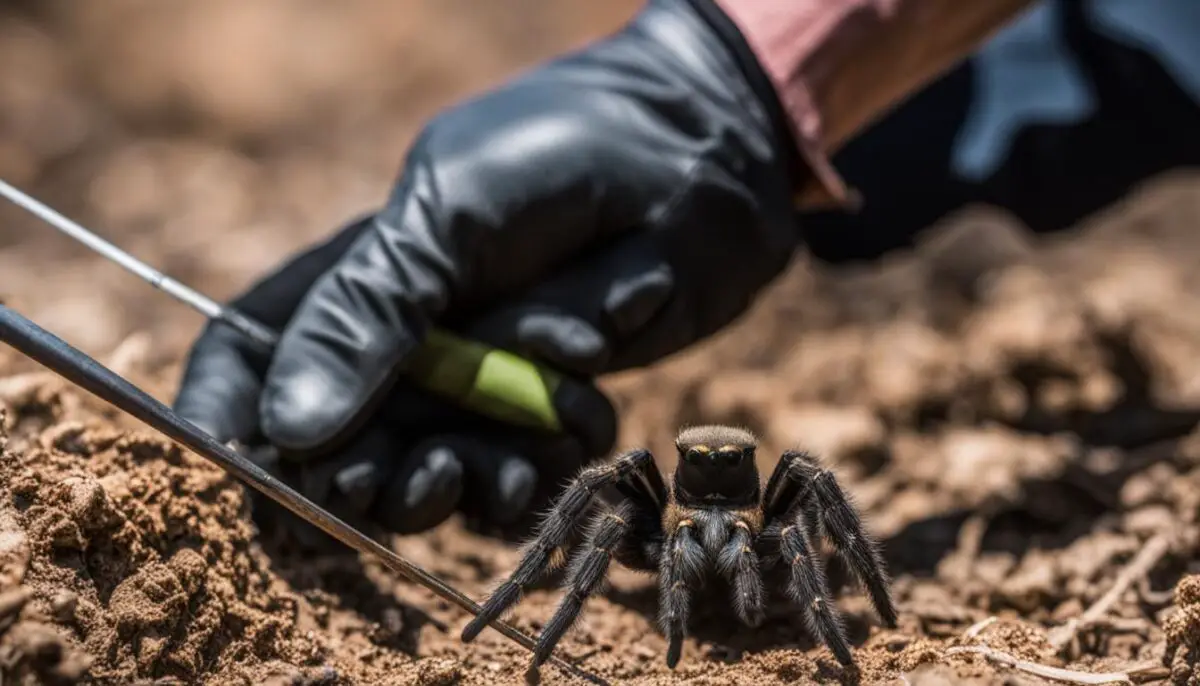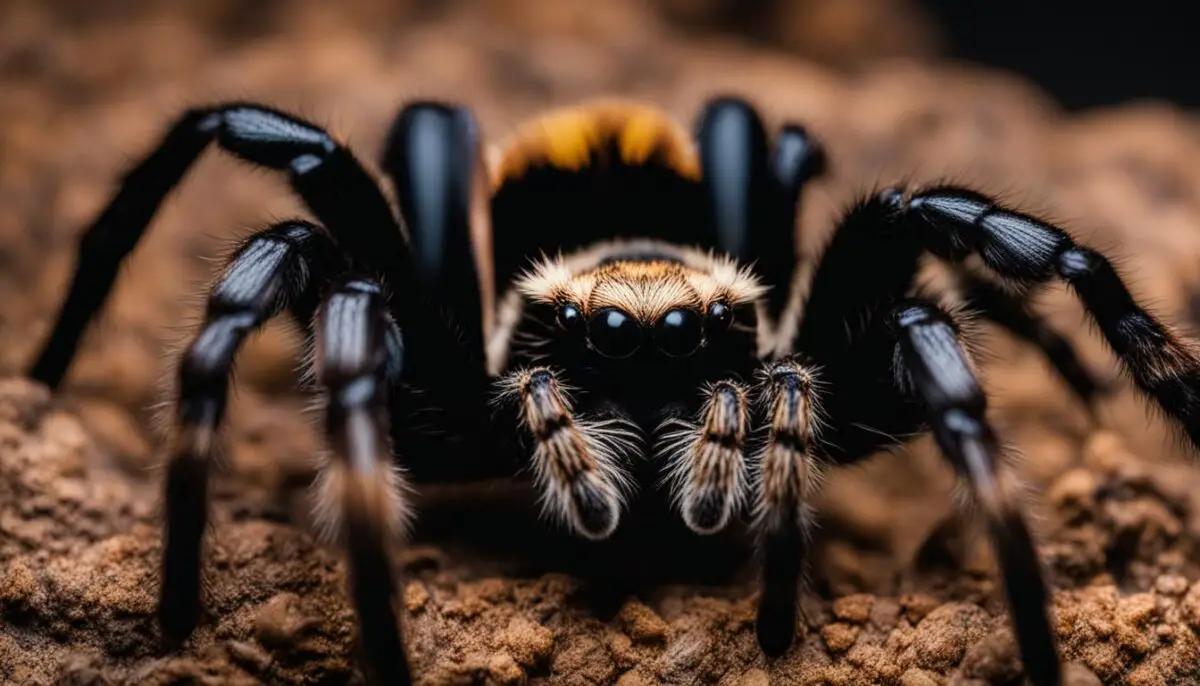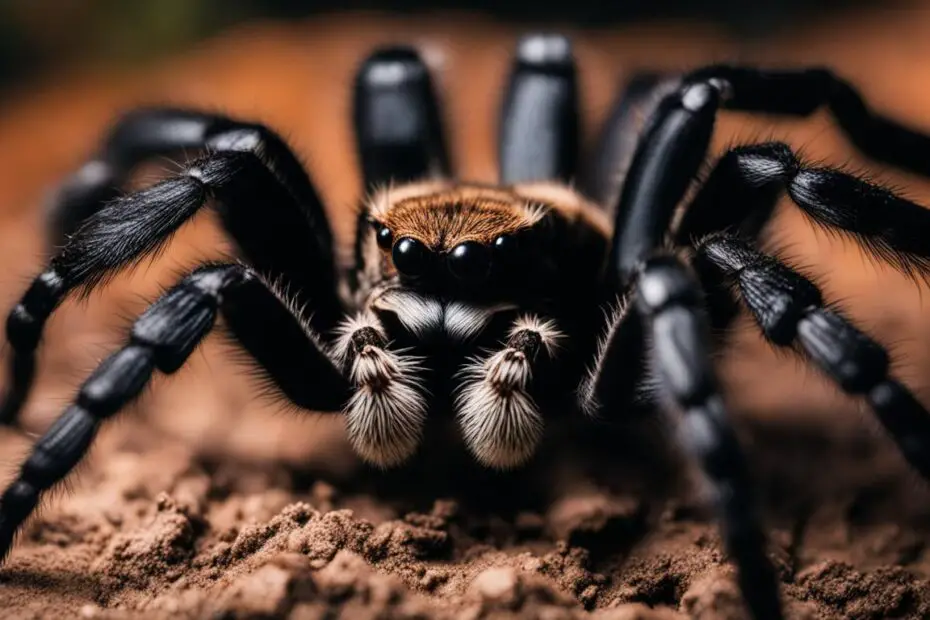Tarantulas are fascinating creatures known for their unique behaviors. While they do not have personalities, they can exhibit varying levels of aggression or defensiveness. In this guide, we will explore the different factors that contribute to tarantula aggression and how to identify and handle aggressive tarantulas.
Research suggests that aggression in tarantulas, such as cannibalism during mating, may be linked to genetic predisposition. Certain species of tarantulas are more prone to aggressive behavior than others. Female tarantulas with aggressive genetics are more likely to attack males in the same way they attack prey. Additionally, their feeding behavior can also be influenced by their aggression, with more cannibalistic females being more voracious eaters.
Key Takeaways:
- Not all tarantulas are aggressive, but certain species are more prone to aggressive behavior.
- Aggressive tarantulas can be fascinating to observe for experienced tarantula keepers.
- Handling aggressive tarantulas should be approached with caution and proper care.
- Creating a suitable habitat is crucial for aggressive tarantulas to thrive.
- Consulting with experts and understanding genetics can help manage and interpret tarantula aggression.
Which Tarantulas Are Aggressive
Benefits of Owning Aggressive Tarantulas
While aggression may not be desirable in pet tarantulas, there are some benefits to owning aggressive species. Aggressive tarantulas can be fascinating to observe because of their unique behaviors. They may also provide more excitement and challenge for experienced tarantula keepers. which tarantulas are aggressive
However, it is important to approach handling and interaction with aggressive tarantulas with caution and proper care to avoid any potential harm. Dealing with aggressive tarantulas requires patience, expertise, and an understanding of their natural instincts. It is crucial to create a safe and secure environment for them, ensuring they have ample space to exhibit their natural behaviors.
One of the benefits of owning aggressive pet tarantulas is the opportunity to learn more about their species-specific behaviors and characteristics. By observing their aggression, tarantula owners can gain insights into their natural instincts and survival strategies. Additionally, interacting with aggressive tarantulas can provide a sense of accomplishment and satisfaction when you are able to handle them safely and build a level of trust.
Identifying Aggressive Tarantulas
When it comes to tarantulas, not all species exhibit aggressive behavior. However, there are certain tarantula species that are known to have more aggressive tendencies. It is important for tarantula owners and enthusiasts to be able to identify these aggressive species to ensure proper care and handling.
Some examples of aggressive tarantula species include the Brazilian black tarantula, Chilean rose tarantula, Mexican red-knee tarantula, and curly hair tarantula. These species are generally docile and suitable for beginners, but it is important to note that individual tarantulas within a species can still vary in temperament. tarantula aggression levels
| Tarantula Species | Aggression Level |
|---|---|
| Brazilian black tarantula | Low |
| Chilean rose tarantula | Low |
| Mexican red-knee tarantula | Low |
| Curly hair tarantula | Low |
It’s important to remember that even with these species, individual behavior can still vary. Therefore, observation and careful handling are essential when dealing with tarantulas, regardless of their aggression level.
Identifying Aggressive Tarantulas
There are a few key indicators that can help in identifying aggressive tarantulas:
- Threat displays: Aggressive tarantulas may display behaviors such as rearing up on their hind legs or flaring their fangs as a warning.
- Aggressive postures: Raised front legs and extended fangs can also indicate an aggressive tarantula.
- Aggressive feeding behavior: Some aggressive tarantulas may exhibit cannibalistic tendencies during feeding, consuming prey or even other tarantulas.
By being aware of these indicators and understanding the specific behaviors of the tarantula species you own, you can better assess their aggression levels and handle them appropriately.
Tips for Handling Aggressive Tarantulas
Handling aggressive tarantulas requires caution and respect for their natural behaviors. While it is generally recommended to minimize handling, there may be instances where it is necessary for maintenance or relocation purposes. Here are some tips to ensure safe and effective handling of aggressive tarantulas: managing aggressive pet tarantulas
- Approach with Caution: When handling an aggressive tarantula, it is important to approach slowly and calmly. Sudden movements or loud noises can trigger a defensive response, increasing the risk of bites or urticating hair release.
- Use a Gentle Approach: Instead of grabbing the tarantula, gently encourage it to walk onto your open hand or a suitable container. This allows the tarantula to feel more secure and reduces the chances of it becoming defensive.
- Keep Tarantula Low to the Ground: To prevent injuries from falls, it is best to keep the tarantula close to the ground or a stable surface. This minimizes the risk of accidental drops and ensures the tarantula remains safe during handling. how to handle aggressive tarantulas
- Wear Protective Gloves: For added safety, it is recommended to wear protective gloves when handling aggressive tarantulas. Gloves provide a barrier between your skin and the tarantula’s venomous fangs, reducing the risk of accidental bites.
Remember, each tarantula has its own unique temperament, even within aggressive species. Observing and respecting their behaviors is essential for both their well-being and your safety. If you’re unsure about handling an aggressive tarantula, it’s best to seek advice from experienced tarantula keepers or professionals.

Expert Tip: Minimal Handling for Aggressive Tarantulas
“Aggressive tarantulas should be handled as minimally as possible to avoid stress and potential harm. It’s important to prioritize their natural behaviors and provide them with a suitable habitat where they can thrive. If you must handle an aggressive tarantula, always approach with caution and use gentle techniques to prevent defensive responses.”
Aggressive Tarantulas as Pets: Setting Up the Habitat
Creating a suitable habitat is crucial when keeping aggressive tarantulas as pets. A well-designed enclosure will provide the tarantula with a secure and comfortable environment to thrive. Here are some essential considerations when setting up a habitat for aggressive tarantulas:
- Enclosure: Choose a secure enclosure with a tight-fitting lid to prevent escapes. Tarantulas are skilled climbers and can quickly find gaps or weak spots in their enclosures. A glass or plastic terrarium with proper ventilation is recommended. Make sure the lid is secure and can withstand the tarantula’s strength.
- Substrate: Add a suitable substrate to the bottom of the enclosure. This can be potting soil, peat, or a specialized tarantula substrate. The substrate should be deep enough for burrowing, as many tarantulas, including aggressive species, enjoy digging and creating tunnels.
- Hiding Places: Provide hiding places for the tarantula to feel secure. This can be accomplished by adding small half logs, cork bark, or clay pots to the enclosure. These hiding places mimic the tarantula’s natural habitat and give them a sense of safety and security.
- Water Dish: Include a shallow dish of clean water in the enclosure. This will provide the tarantula with a source of hydration. Make sure the dish is shallow enough for the tarantula to access easily, but not deep enough for it to drown.
- Temperature and Humidity: Research the specific temperature and humidity requirements of your tarantula species. Some aggressive tarantulas prefer warmer and more humid environments, while others thrive in drier conditions. Use a thermometer and hygrometer to monitor and maintain the appropriate conditions.
Remember to regularly clean the enclosure and provide fresh water. Observation and monitoring of the tarantula’s behavior and health are essential for ensuring its well-being. Consulting with experienced tarantula keepers or professionals can provide additional guidance on specific species’ requirements and enhance your knowledge as a tarantula owner.
Safety Precautions When Dealing with Aggressive Tarantulas
Dealing with aggressive tarantulas requires careful consideration and adherence to certain safety precautions. These measures are essential to ensure the well-being of both the handler and the tarantula. Here are some important safety guidelines to follow when interacting with aggressive tarantulas:
1. Protective Gloves:
When handling aggressive tarantulas, it is advisable to wear protective gloves to minimize the risk of being bitten or stung. These gloves act as a barrier between your skin and the tarantula’s venomous fangs, providing an extra layer of protection.
2. Avoid Sudden Movements:
Aggressive tarantulas can perceive sudden movements as threats, triggering defensive behaviors. To minimize the chances of a tarantula becoming defensive or aggressive, it is important to avoid rapid movements or gestures that may startle or provoke them.
3. Quiet Environment:
Tarantulas are sensitive to vibrations and loud noises, which can agitate them. To create a calm and stress-free environment for your tarantula, it is recommended to keep the surroundings quiet and minimize any disturbances or loud sounds.
4. Keep Children and Pets Away:
It is crucial to keep children and other pets away from the tarantula’s habitat to prevent any potential harm. Tarantulas should be kept in a secure enclosure that is inaccessible to curious hands or paws. This ensures the safety of both the tarantula and those around it.
By following these safety precautions, you can create a safer and more controlled environment when dealing with aggressive tarantulas. Remember, it is essential to prioritize the well-being and natural behaviors of these fascinating creatures to ensure a positive and fulfilling pet ownership experience.

Common Aggression-Related Behaviors in Tarantulas
Aggressive behavior in tarantulas can vary and manifest in a variety of ways. By understanding these behaviors, tarantula owners can better interpret and respond to their pet’s actions. Some common aggression-related behaviors in tarantulas include:
1. Threat Displays
Tarantulas may exhibit threat displays as a way to intimidate perceived threats. These displays can include rearing up on their hind legs or flaring their fangs. It is important to note that a threat display does not necessarily mean the tarantula will attack, but rather it is a warning sign.
2. Aggressive Postures
Aggressive tarantulas may assume specific postures to demonstrate their readiness to defend themselves. This can include raising their front legs and extending their fangs in a show of aggression. These postures serve as a warning to potential predators or threats.
3. Biting
When feeling threatened, tarantulas may resort to biting as a defensive mechanism. Bites from tarantulas can be painful and may cause localized swelling or irritation. It is crucial to handle tarantulas with care and avoid situations that may provoke them to bite.
Understanding these aggression-related behaviors can help tarantula owners create an environment that promotes the well-being of their pets while also ensuring their own safety. By observing and respecting the natural behaviors of these fascinating creatures, tarantula owners can build a strong bond with their pets and provide them with the care they need.
| Behavior | Description |
|---|---|
| Threat Displays | Rearing up on hind legs or flaring fangs to intimidate threats. |
| Aggressive Postures | Raising front legs and extending fangs to display aggression. |
| Biting | Using their fangs to defend themselves when feeling threatened. |
Handling Aggressive Pet Tarantulas: Expert Advice
Handling aggressive pet tarantulas requires expertise and caution. As a tarantula owner, it is essential to consult with experienced tarantula keepers or professionals who can provide valuable advice and guidance on safely interacting with aggressive tarantulas. These experts can help you understand the specific behaviors of the tarantula species you own and offer insights into managing their aggressive tendencies.
When handling aggressive tarantulas, it is important to prioritize the well-being of both the tarantula and the handler. Experts may recommend minimizing handling, especially for aggressive species, to avoid any potential harm. However, if handling becomes necessary, they can provide techniques and tips to ensure the safety of both you and your tarantula.
It is crucial to remember that each tarantula is an individual and may have unique temperaments, even within the same species. Therefore, observing and understanding your tarantula’s body language and behaviors is key to safe handling. By closely watching their postures, movements, and other cues, you can better interpret their actions and adjust your handling approach accordingly.
Important Safety Precautions
Here are some important safety precautions to keep in mind when dealing with aggressive pet tarantulas:
- Wear protective gloves to provide a barrier between your skin and the tarantula’s venomous fangs.
- Avoid sudden movements and loud noises that may startle the tarantula and trigger defensive behaviors.
- Keep children and pets away from the tarantula’s habitat to prevent any potential harm or accidents.
| Handling Aggressive Pet Tarantulas: Expert Advice | |
|---|---|
| Consult with experts | Experienced tarantula keepers can provide valuable advice and guidance on safely interacting with aggressive tarantulas. |
| Minimize handling | Handling should be avoided or minimized, especially for aggressive tarantula species, to prevent any potential harm. |
| Observe body language | Understanding your tarantula’s body language and behaviors is crucial for safe handling and interpretation of their actions. |
| Safety precautions | Wear protective gloves, avoid sudden movements and loud noises, and keep children and pets away from the tarantula’s habitat. |
By following these expert recommendations and taking the necessary safety precautions, you can ensure a positive and safe handling experience with your aggressive pet tarantulas. Remember to always prioritize the well-being of both yourself and your tarantula, and consult with professionals for any specific advice related to the species you own.
The Role of Genetics in Tarantula Aggression
Genetics play a significant role in determining the aggression levels of tarantulas. Certain species have inherently more aggressive genetics, which can result in higher levels of aggressive behavior. This genetic predisposition may be linked to various factors, including survival instincts and mating behaviors. Understanding the influence of genetics on tarantula aggression can provide valuable insights into their behaviors and enable tarantula owners to better manage and interpret their actions.

It is important to note that not all tarantulas exhibit aggressive behaviors to the same extent. Some species are more prone to aggression, while others are more docile. By identifying the aggressive tarantula species, owners can be better prepared for handling and caring for these particular individuals.
Awareness of tarantula genetics can also aid in creating suitable environments for aggressive tarantulas. Understanding their predisposition towards aggression can help owners design appropriate habitats that provide the necessary security and stimulation for these unique creatures.
In summary, the role of genetics in tarantula aggression is a crucial factor to consider for both tarantula keepers and researchers. By recognizing the genetic predisposition of certain species and understanding their behaviors, owners can provide the best possible care for aggressive tarantulas while minimizing potential risks.
Conclusion
Owning aggressive tarantulas can be a rewarding experience for experienced tarantula keepers. However, it is essential to approach their care and handling with caution and respect for their natural behaviors.
Identifying aggressive tarantulas is an important step in providing the best possible care. Understanding the specific behaviors and temperaments of different species can help you create suitable habitats and manage their behaviors effectively.
Taking appropriate safety precautions is crucial when dealing with aggressive tarantulas. Wearing protective gloves and avoiding sudden movements can help prevent any potential harm. It is also important to keep children and pets away from the tarantula’s habitat to ensure everyone’s safety.
Consulting with experts and understanding the role of genetics in tarantula aggression can further enhance your knowledge and skills as a tarantula owner. By seeking guidance from experienced tarantula keepers, you can gain valuable insights into handling aggressive tarantulas and managing their behaviors.
FAQ
Do tarantulas have personalities?
Tarantulas do not have personalities, but they may exhibit more aggressive or defensive temperaments.
What causes aggressive behavior in tarantulas?
Aggressive tarantula behavior, such as cannibalism during mating, may be linked to genetic predisposition.
Are all tarantulas aggressive?
Not all tarantulas are aggressive, but there are certain species that are known to have more aggressive tendencies.
How should I handle aggressive tarantulas?
Handling aggressive tarantulas should be approached with caution and respect for their natural behaviors. Minimize handling and allow the tarantula to walk onto your open hand rather than grabbing it.
What safety precautions should I take when dealing with aggressive tarantulas?
Wearing protective gloves, avoiding sudden movements and loud noises, and keeping children and pets away from the tarantula’s habitat are important safety precautions.
How can I identify aggressive tarantulas?
Some aggressive tarantula species include the Brazilian black tarantula, Chilean rose tarantula, Mexican red-knee tarantula, and curly hair tarantula. However, individual tarantulas within a species can still vary in temperament, so it is essential to observe and handle each tarantula carefully.
What should I consider when setting up a habitat for aggressive tarantulas?
A secure enclosure with a tight-fitting lid, a substrate for burrowing, hiding places, and a shallow dish of water for hydration are important components of a tarantula habitat.
What are common aggression-related behaviors in tarantulas?
Aggression in tarantulas can manifest in threat displays, aggressive postures, biting, or releasing urticating hairs as a defense mechanism.
How can I handle aggressive pet tarantulas?
Expert advice is recommended for handling aggressive pet tarantulas. Consult with experienced tarantula keepers or professionals for guidance on the specific species you own.
What role does genetics play in tarantula aggression?
Some tarantula species have inherently more aggressive genetics, leading to higher levels of aggressive behavior.

